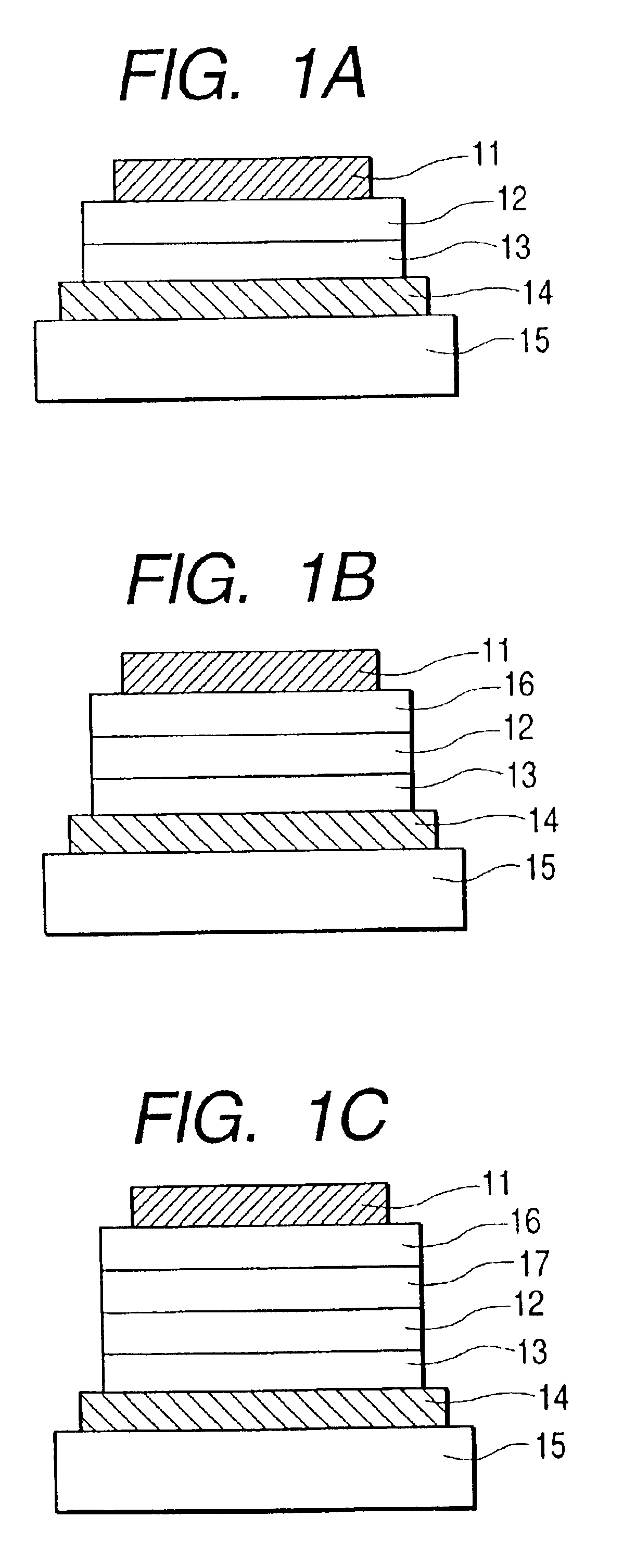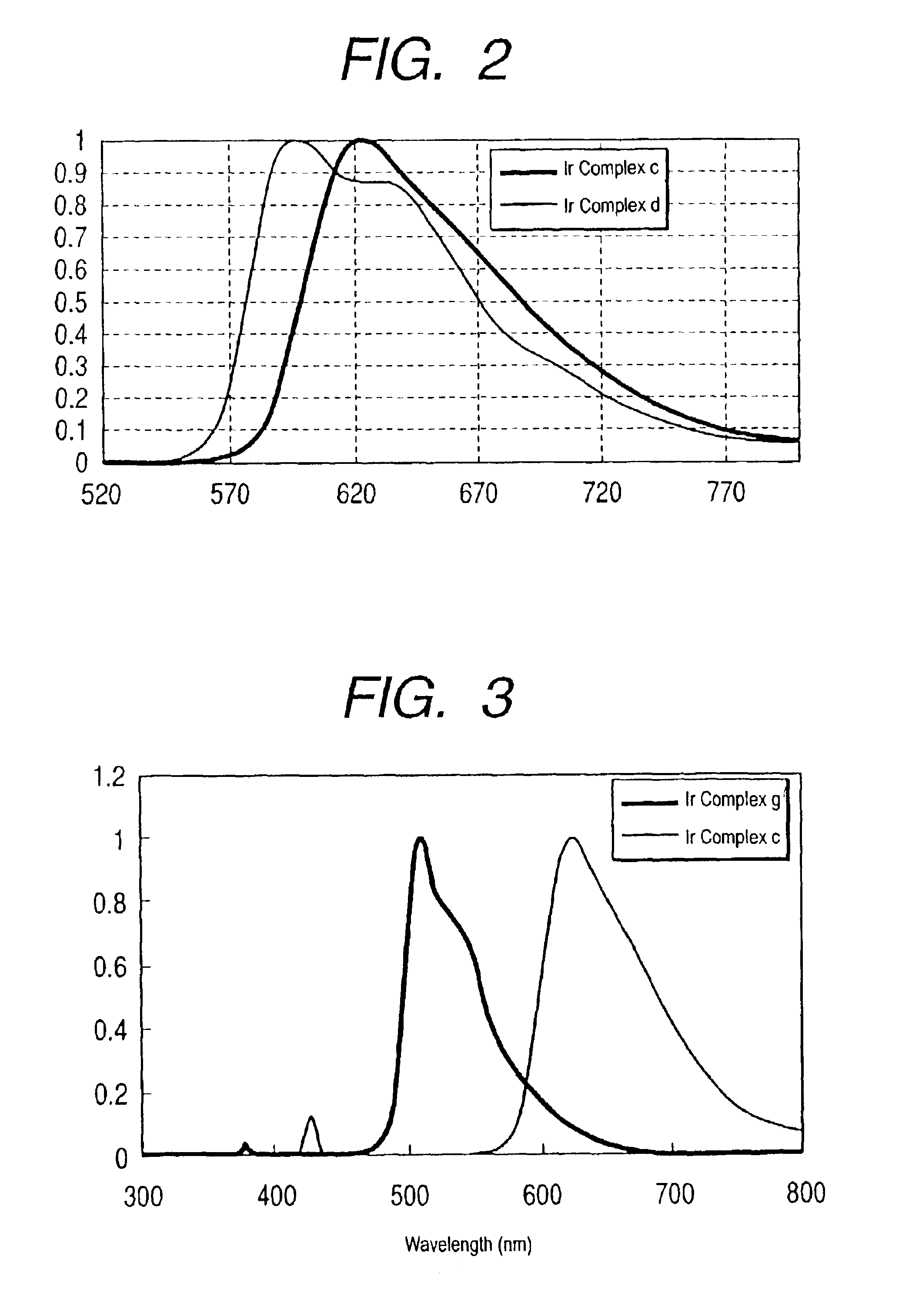Light emitting device having a dopant in a light emitting layer and method of producing the light emitting device
a light emitting device and light emitting layer technology, applied in the direction of discharge tube luminescnet screen, other domestic articles, natural mineral layered products, etc., can solve the problems of low charge injecting and charge transporting properties, loss of light emitting efficiency of the device, and difficulty in causing a large current, etc., to achieve low-voltage drive, high efficiency, and high luminance
- Summary
- Abstract
- Description
- Claims
- Application Information
AI Technical Summary
Benefits of technology
Problems solved by technology
Method used
Image
Examples
example 1
A device was prepared by employing CBP as the host material of a light emitting layer and doping the light emitting layer with the Ir complex C as the light emitting material at a concentration of 7 wt. % and with the Ir complex A as the light emitting compound at a concentration of 3 wt. %. The employed Ir complex A has a function of increasing the current in the device, thus also serving as the current enhancing material.
example 2
A device was prepared by employing CBP as the host material of the light emitting layer, and doping the region of a thickness of 10 nm at the side of the hole transport layer within the light emitting layer of a thickness of 40 nm, with the Ir complex C as the light emitting material at a concentration of 7 wt. % and with the Ir complex A as the light emitting compound at a concentration of 3 wt. %, while co-evaporating the Ir complex C alone at a concentration of 7 wt. % in the remaining 30 nm region. The employed Ir complex A has a function of increasing the current in the device, thus also serving as the current enhancing material.
Table 2 shows the results of measurement of current and luminance of the above-described device and the device of the comparative example 11 under the application of a DC voltage of 10 V.
TABLE 2Current (mA / cm2)Luminance (cd / m2)Example 223.5621Comp. Ex. 1111.8426
The results in Table 2 confirm that the device of the example 2 showed an increase in the cur...
example 3
In this example, there was employed a device configuration with a four-layered organic layer as shown in FIG. 1C. An ITO film (transparent electrode 14) of a thickness of 100 nm was patterned on a glass substrate (transparent substrate 15). On thus prepared ITO substrate, following organic layers and electrode layers were formed in succession by vacuum evaporation by resistance heating in a vacuum chamber of 10−4 Pa:
Hole transport layer 13 (40 nm): FL03 (following chemical formula)
Light emitting layer 12 (40 nm): host material+light emitting material 1+light emitting material 2
Electron transport layer 17 (50 nm): Bphen (following chemical formula)
Electron injection layer 16 (1 nm): KF
Metal electrode layer (100 nm): Al
It was so patterned that the electrodes had an opposed area of 3 mm2.
In forming the light emitting layer 12, the Ir complex C was employed as the light emitting material 1, and the Ir complex D was employed as the light emitting material 2.
(Ir Complex D)
The Ir comple...
PUM
| Property | Measurement | Unit |
|---|---|---|
| Time | aaaaa | aaaaa |
| Time | aaaaa | aaaaa |
| Time | aaaaa | aaaaa |
Abstract
Description
Claims
Application Information
 Login to View More
Login to View More - R&D
- Intellectual Property
- Life Sciences
- Materials
- Tech Scout
- Unparalleled Data Quality
- Higher Quality Content
- 60% Fewer Hallucinations
Browse by: Latest US Patents, China's latest patents, Technical Efficacy Thesaurus, Application Domain, Technology Topic, Popular Technical Reports.
© 2025 PatSnap. All rights reserved.Legal|Privacy policy|Modern Slavery Act Transparency Statement|Sitemap|About US| Contact US: help@patsnap.com



